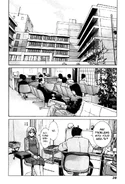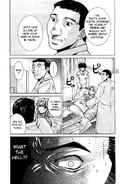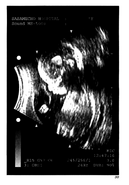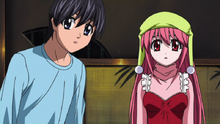
"What do you mean "Sapporo is a city in Hokkaido?' I thought it was just a brand of beer! ...I should brush up on my own background."
Miscellaneous Locations are defined here as those locations directly or indirectly referenced but not depicted within the Elfen Lied series, both versions. Locations briefly depicted that do not merit their own article due to insufficient amounts of information and/or limited screentime also qualify.
Basically, if it takes two or fewer full paragraphs to describe the location and its significance, it goes here!
Regarding images for locations, please limit images to one per location description. Two images may be used if there is enough script (about two paragraphs) to balance out the large amount of negative space created when inserting an extra image to the page.
For locations relating to the merchants encountered during the series, please refer to our Businesses article.
Hokkaido[]
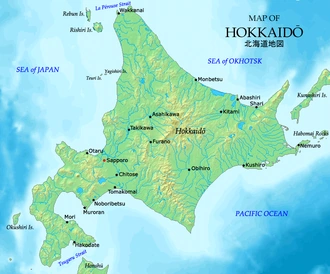
The northernmost and second largest of Japan's four major islands, Hokkaido Prefecture is the birthplace and original home of the series deuteragonist, Kouta, as well as his younger sister Kanae and their father. Since so little information is known about the characters' history, it is also unknown how they were connected to Yuka and her parents, or whether either of the families had their origins in Hokkaido or Kamakura.
Absent solid information, the series still offers room to safely extrapolate about Hokkaido's other roles in the series. During Lucy's extended flashback concerning the early events that shaped her, young Kouta tells her that jade (which he assumes the green stone he gives her is) can be made into rings, according to his grandmother, who he seems to refer to in the present tense. This is the only reference to his grandmother in the series, but it offers two possible insights, based on real world information. If she was alive at that time, then Kouta's grandmother or grandparents become very likely candidates to take the young boy in, after Lucy's murder of Kanae and their father. Since Kouta's father was still a young man, his parents or in-laws being alive becomes that much more likely. Again, which family they are related to is never even hinted at. Also, since most mental therapists would likely want Kouta removed from the place of his trauma, the question some have had concerning why Yuka's mother didn't take him in seems to have its answer here : Her rights, if she wished to take him in, would have been superseded by a grandparent, and likely she would never have contested this. Also, for Kouta's sake, post-trauma, Kamakura would have been the worst place for him to be, awakening memories he was not remotely prepared to deal with. Only the anime speaks of Kouta staying in an undefined hospital for a year following the murders, while only the manga mentions his grandmother. Additionally, Hokkaido itself is only mentioned very peripherally. But since none of these elements preclude assuming them all to be true for both versions, it may also answer one of the prime unanswered questions in Kouta's backstory.
Another possible inference to be drawn from Hokkaido affects the entire series. Hokkaido is an ancestral center of Japan's indigenous Ainu people. An ethnically distinct group from most Japanese, this group, now vastly dwindled in recorded number, was historically both traded with and warred on by Yamato Japanese, called Wajin by the Ainu, and at times was even enslaved. While not a precise parallel, this long history of strife between the Yamato Japanese and the indigenous Japanese people (including the Emishi of Honshu) can be seen as a real-world precedent for the treatment of both the actual Diclonius and the ancestors of the Kakuzawas, the so-called Original Diclonii, by the humans that outnumber them.
On a positive note, cultural exposure to a more ethnically diverse area could explain part of why Kouta so easily accepted young Lucy.
Gokurakuji Temple[]
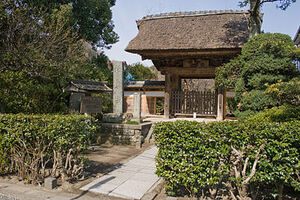
Gokurakuji Temple
The Gokurakuji-Ji was founded in 1259 and is a temple of the Shingon Buddhist Sect, founded by the priest Ninsho.
In Elfen Lied, it is not depicted or mentioned, but a great many sites directly adjacent to it are central locations in the series, and therefore this temple is always right around the corner of a great many events pivotal to the narrative.
Gokurakuji Train Station, Jouju-in Temple, Jouju-in Cemetery, Yuigahama Beach, and the Michibiki Jizoudou are all within arguable reach of this temple, defined not by its presence in the series but by what surrounds it.
Aiko Takada's Apartment[]
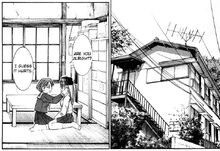
The Takada apartment.
The apartment where Aiko Takada and her father lived was in Kamakura, but it's exact location is never given. It was situated near a park where Aiko would often see an adolescent Lucy sitting by herself. The apartment was small, as they tend to be not only in urban environments but especially in Japan's closely-packed cities. Judging by the cramped space and the cracks in some parts of the walls, Aiko's father most likely left the cleaning to Aiko despite her having to work to pay some of the rent. The apartment's small size contributed greatly to the altercation between Aiko and her father in Chapter 85. Mr. Takada's earlier encounter with Lucy dislodged the painting Aiko was hiding in the attic, and he was so furious at the sight of the painting that he tried to cut it up, only to slice his own neck open as Aiko pushed him and threw off his aim.
Yuka's Mother's House[]
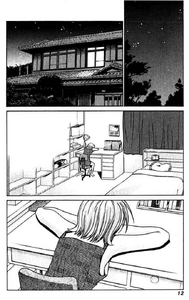
Yuka's house and bedroom (manga version)
This house is never seen in Elfen Lied proper save for a single shot of a portion of its exterior and the interior of Yuka's bedroom in Chapter 8. In the anime, only Yuka's bedroom is shown in Episode 3. Based on what parts of it can be seen, the house is of traditional Japanese design, has at least two stories, and is surrounded by trees. The latter makes it possible it's located in one of the many wooded areas in Kamakura. The house was most likely Yuka's childhood home. It seems to also be where Kouta's family spent part or most of the fateful summer when he met young Lucy.
The house's apparent size, Yuka's bedroom size (or what's visible of it), and the fact that Yuka's mother owns the Maple House suggest Yuka's side of the family is well-to-do in terms of money or at least are very comfortable financially. This supposed wealth could explain why Yuka and Kouta had no apparent need for jobs, since Yuka's mother let Kouta live in the Maple House rent-free so long as he maintained the place, how the bills (water, electric, etc.) were paid, and if Yuka was on any sort of allowance, that would cover the cost of groceries.
Mayu's Mother's House[]
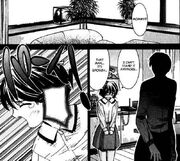
A house is not a home, one who gives life is not a mother.
The few images that exist of this place do seem to indicate it is an actual house, and not an apartment. Mayu seemed to have her own, separate room. It is difficult to discern in what room Mayu was assaulted by her stepfather. A living room-type area is also indicated, in scenes Mayu first meets her stepfather and when Kouta and Yuka meet with Mayu's mother and gain her agreement to essentially let the young couple take custody of her. From what details are visible, it seems a well-kept home, perhaps deliberately contraindicating the many dark secrets it contained. Later in the manga, when Mayu struggles with the Unknown Man, she recalls an earlier rape by her stepfather. While presumably this occurs inside the home, no indications of the space involved are given or presented.
The Kuramas' Apartment[]
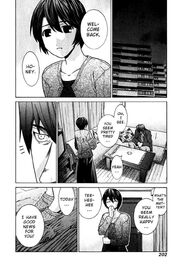
The Kurama apartment.
Really seen only once, and then only in the manga version, it is unclear whether or not this is an apartment the married couple have lived in for quite some time or recently moved to, following Doctor Kurama's employment at the Diclonius Research Institute. It seems to be a comfortable place, perhaps set up with Hiromi's comfort in mind due to not only her frail constitution but the couple's attempts at pregnancy as well, and is in a building several stories high, suggesting it's located deeper within the city's metro area and perhaps more expensive than a typical apartment because of it.
While the apartment itself is simple, it does raise questions about how the staff at the Institute lived. Being on an island location with high elevation, transport strictly by air seems a given, and regular commuting for all but the topmost tier of managers seems unlikely. It is possible that lower-ranked staff spent weeks to months at a time before returning to the mainland. Sudden, very possibly lethally created openings in the staff roster likely also meant stays extended well beyond original agreements, especially given the security clearance of the project and the controlling nature of the Kakuzawas. It seems possible that eventually Kurama lived in quarters on the island itself, made doubly likely by his high-ranking position and a desire to avoid a place that reminded him of Hiromi and Mariko. Of course, Mariko was held deep within the facility, which would be more stressful than the old apartment where they used to live.
Nozomi's Father's House[]
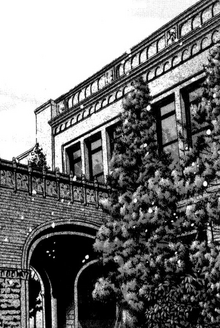
A gilded cage for a nightingale.
Like so many of the lesser-seen locations, there is not much to say to describe Nozomi's house. But, as with Nozomi's parents, there may actually be more to learn about this house than many others more pivotal and some more frequently seen. Owing to one chapter stating that Nozomi's father's opposition to her dream of singing opera is based on his wishing her to join the family business, Nozomi's family home is rather large and of western design as a sign of her family's wealth. The living room appears spacious, and the stereo equipment seen seems modern and visible, perhaps an investment from when his wife was alive and had a noted operatic singing career. In one of the final manga chapters, Nozomi is seen at a window as she recovers from having her throat crushed during the surprise attack on the Maple House earlier. The room she's staying in has a raised bed with valances rather than a more typical futon, a clue to her family's lavish decor.
The home also appears to be somewhat away from the areas of Kamakura more central to the series, perhaps near the city's northeastern or northwestern hilly areas, as the chaos created by Lucy's final actions visibly concern Nozomi's father, but he's not outright panicking. Their need to get to a shelter is spoken of more as just something that needs to be done rather than an emergency to be done that very moment.
The Kakuzawa Home[]
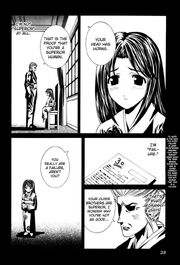
A spacious home, but utterly cold.
Only a single scene of this place is shown, during the manga chapter that describes Anna Kakuzawa's childhood and transformation into the monstrous Oracle. The impression given is of a large house with scenic windows, though Anna is only presented as alone in it, trying her best to succeed academically and being told of her failures so often, she thinks of herself as one without truly realizing what it means. Only her room with a simple desk and what looks like a common living area are depicted. Anna is said in one passage to have 'brothers' (note the plural) and this would seem to exclude the grown Professor Kakuzawa but also the Male Diclonius, indicating other siblings or perhaps live-in cousins, indicating perhaps a very large mansion. What use the family had for this place as their grand generational plans came to fruition or whether this house was located in an area defensible as potential chaos erupted from these plans is not known.
Locations in the manga conclusion[]
Two possible locations are suggested but never depicted in the manga series' final chapter. While they exist mainly through extrapolation, it is a solidly-based extrapolation.
One location is brought up when Nana is speaking at what turns out to be Mariko's gravesite, and she states that she and Kurama are now living together. This is never expanded upon, but can be looked at with other story elements in mind. One school of thought simply goes that Nana lost her fight with Yuka's mother and was forced to move out of Maple House. This may be contraindicated by Nana still being with the group when Kouta begins returning to the spot where he first met young Lucy, this sequence at least shown after the scene at Mariko's grave. If Yuka's mother's concern was the danger created by Nana living with the others, then allowing them to associate with her seems to defeat the purpose of safety. The other school of thought says that not only did Nana (by way of Yuka and Kouta) prevail and remain in Maple House, but asked her 'Papa' to join the rest of her new family. This is possibly contraindicated by the fact that Kurama shot Kouta, nearly ending his life. Yet Kouta had been prepared to allow Lucy to live with them, certain conditions allowing, even after he regained his memories, for her much more deliberate, horrid crimes against him. In light of his affection for Nana and the conditions and intent surrounding Kurama's shooting, Kouta forgiving Kurama seems at least possible. A third alternative has Yuka's mother giving up in her effort and simply allowing Nana to associate with the others while living elsewhere. One question does arise from the description of Kurama spending time away while he finds others involved in Kakuzawa's conspiracy. While a child of Nana's physical age could be left alone, particularly in Japan, and while Nana had matured greatly, she was still largely unworldly and in a situation where her horns could draw negative attention. More information is simply not available.
The second location is the home that Kouta, his wife (presumably Yuka) and their daughter, Nyuu Junior use at the time we see two of them, said to be ten years after Lucy's death. While it is possible the main cast or much of it remained living in Maple House, logic would seem to argue against it. Nozomi and Mayu would be grown, mature women, while Nana would look to be in her mid-thirties, due to doubled Silpelit aging. College would be done for the married couple, and maintaining a large house alone while raising a child might be too overwhelming, presuming Yuka's mother didn't wish to refurbish the place to its original purposes as an inn and restaurant. On the other hand, in a Japan and a world torn by the Diclonius War, and given the harsh events that forged them as a family, they might all just stay together, perhaps more loosely knit than before, but still centering on and helping to maintain Maple House. By inference, Kouta's new family had to live somewhere, but where that might be can only be guessed at.
Side Story Beach[]
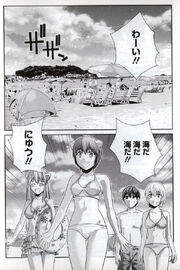
Beach Blanket Bingo - Diclonius Style!
Seeking relief on a particularly hot day, the residents of Maple House make out for the beach to enjoy the surf, sand and fun. The beach here seems not to be the central location of Yuigahama Beach, but rather one much closer to the Sea Candle and Enoshima, perhaps Katase Beach, eastern part of it.
This location appears strictly in the manga-format but anime-only continuity short piece that was featured in a bonus short drawn and written by Lynn Okamoto in order to celebrate and promote the release of the anime series on Blu-Ray.
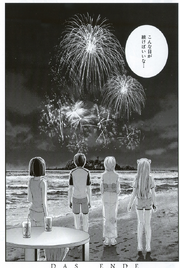
The fireworks display after sundown.
The story is markedly different from much of the series, and the location detail as well as the order of the day are said to be more in keeping with stories the mangaka had wanted to tell with the characters. This alternate beach may even have some manner of mystic properties : Both Nana and Nyu go about having fun without any sort of headwear to hide their horns, even with perennial nemesis Bando cleaning up litter and harassing litterbugs right nearby.
The beach was shown to be crowded on the hot day, and featured a fireworks display at nighttime.
Kamakura's Other Train Stations[]
These are different and separate train stations from Gokurakuji Train Station. Both appear to also be part of the Enoden line.
One unnamed is seen chiefly on the cover to Manga Chapter 73, with Nyu waiting on the train platform overlooking traffic by the shoreline.
With the other, Nana is nearby, but not at the station, when pursuing Mariko in Chapter 55. This one appears to be Kamakura High School Station, but this cannot be confirmed.
Tanegashima Island[]
Tanegashima Island is part of an archipelago in Kagoshima Prefecture in Japan. It is known for a rich history with the Kamakura Shogunate, a tradition of small arms manufacturing, and a noted space vehicle launching facility. This seems to be where Chief Kakuzawa launched the deceptively-labeled weather satellite that was the cover for the bacilli-carrying missile laden with the weaponized form of the Diclonius birth virus.
Onigashima Island[]
Onigashima is a mythical island associated with the legend of the Heaven-sent hero Momotaro. In this story, the hero boy pursues a tribe of demons to their home, and makes a captive/trophy out of their chieftain. It is mentioned by Chief Kakuzawa to Arakawa, newly arrived in the Lebensborn Grotto and overwhelmed by the sheer alien-ness of the place. The fact that the Chief seems to do this in a humorous light could be an indicator that the tale of Momotaro at Onigashima (at least within this fictional universe) was based off of the persecution of his ancestors. Conversely, the Chief could simply be snarking about his perceived outsider status by identifying his ancestral location with this mythic demon lair.
Sasamecho[]
A town or area far north of Kamakura, nearer to Tokyo. It appears in Manga Chapter 72. In it, a doctor views a pregnant woman's ultrasound, revealing that her unborn child is a Diclonius, and through this, that the plans of Chief Kakuzawa are coming to fruition. Like other real life locations depicted in the manga series, its representation of the area's hospital may not be entirely accurate.
| ||||||||

